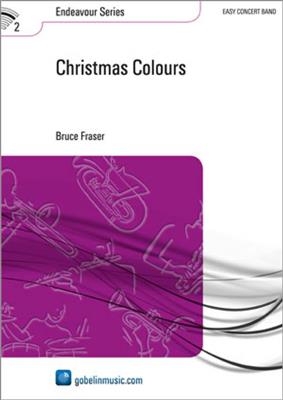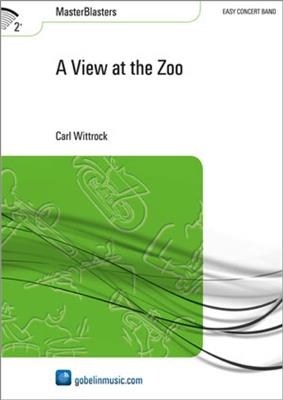Results
-
£139.99
The Groove Makers - Peter Kleine Schaars
The idea behind The Groove Makers is that all musicians, regardless of training or musical taste, can play together if they all keep the same 'groove.' This inspired Peter Kleine Schaars to write a piece everyone would enjoy and to give the concert band a trendy 'groove' that the audience can really connect with.
Estimated dispatch 7-14 working days
-
 £122.50
£122.50European Journey
Lszl Zemplni, the author or reviser of a large number of pedagogical volumes published by EMB, has this time arranged European folk songs for young band. The following songs feature in the volume: "La' doch meine Jugend" (German), "My native land" (Irish), "Ah mon beau chteau" (French), "Kom, skal i klippe" (Norwegian), "Moj llokumja me sheqer" (Albanian), "Ma come balli bella bimba" (Italian) and "Az olhok, az olhok" (Hungarian). The pieces can be performed as a coherent series or separately, and conductors can select from them to form 2-, 3- or 4-movement groups.
Estimated dispatch 7-14 working days
-
£53.95
Orpheus Overture - Jacques Offenbach
This superb arrangement features three famous melodies from Offenbach's overture to Orpheus in the Underworld. While many students are familiar with the famous Can Can, few have had the chance to explore it in such an authentic setting. Treat yourself and your band to one of the best-known overtures in classical music, from one of the most prolific educational arrangers in the country!
Estimated dispatch 7-14 working days
-
 £60.99
£60.99Scottish Festival Overture - Bruce Fraser
The Scottish composer, Bruce Fraser, has always devoted himself to educational music. In this composition, in which his love for Scotland can be heard, again, he has clearly considered the possibilities of the orchestra. A delightful concert piece which can be performed well by beginning bands.
Estimated dispatch 7-14 working days
-
 £60.99
£60.99Christmas Colours - Bruce Fraser
'Christmas Colours' is a palette consisting of several Christmas songs. Bruce Fraser has mainly used the colours green (the colour of holly) and white (the colour of snow). This composition begins with the chiming of festive bells - if you listen well, however, you can already hear short fragments from 'The Holly and the Ivy', whose entire melody is finally played, alternated with 'The Sussex Carol'. After this, the pace slows down and the stately 'See amid the Winter Snow' sounds, but parts from 'Jingle Bells' and 'Silent Night' can also be heard. Then, after walking under 'The Holly and the Ivy' once again, the celebration of Christmas may begin!
Estimated dispatch 7-14 working days
-
 £144.99
£144.99Like a Child - Andreas Ludwig Schulte
The young have the future. This is the statement made at the beginning of 'Like a Child' by Andreas Ludwig Schulte. The opening radiates strength and ambition, but one is also made to wonder which direction will be chosen, which choices will have to be made.After the introduction the first steps on the path of life are taken, still somewhat unsteadily (the 3/4th time used illustrates this uncertainty). However, the child has now set off and will meet the future with an open mind, unafraid, even though experience will teach it how easily it can be hurt.Fortunately, it is sometimes allowed to be vulnerable and it discovers there will always be someone to offer shelter,support and love. (Adagio) The last part breathes a far greater independence. Youth is able to face the future, it can even take on the whole world!
Estimated dispatch 7-14 working days
-
 £137.99
£137.99A View at the Zoo - Carl Wittrock
The composition as a whole is built around a structure of shorter fragments reminiscent of 'Pictures At An Exhibition' by Moussorgsky. The parts are decorated with recognisable illustrations of different animals. In each composition, Wittrock adds something that can fascinate both musicians and listeners. Can you hear it?
Estimated dispatch 7-14 working days
-
 £47.50
£47.50First Concepts Warm-ups - Larry Norred
This is one or the most interesting, useful teaching aids ever developed for beginning bands. It's full of chorales, exercises and rounds, all designed to reinforce concepts you are trying to teach in day to day work. The percussion section gets special emphasis, with parts that will keep the players' attention without being too difficult. The PENTATONIC TECHMIQUE BUILDER section can be used in many ways. Since it is all pentatonic, you can even craft your own approaches using any Orff-style techniques you may prefer.
Estimated dispatch 7-14 working days
-
 £47.50
£47.50Tyrannosaurus Rocks - Mike Hannickel
You've heard of the legendary Tyrannosaurus Rex. Well, this Tyrannosaurus ROCKS! Another fun one for Beginning Band by Mike Hannickel, it's as easy as can be but the kids will love it. If you have an old sousaphone and a baritonesax mouthpiece you can make a mighty Tyrann-o-Phone for the optional solo at the end of the piece. (Grade 1/2)
Estimated dispatch 7-14 working days
-
 £60.99
£60.99Land of Tomorrow - James Curnow
Framed through variation around the great old shape-note melody When I can read my title clear, James Curnow's significant new composition, Land of Tomorow, is a wonderful expression of the composer's art. While traversingcountless moods, the flow and continuity never falter, and the interest never fades. The band that plays at this level can only gain skill and knowledge through meticulous preparation of this enthralling composition. Every playercan take deep satisfaction from a solid performance of this masterpiece. Powerful!
Estimated dispatch 7-14 working days
